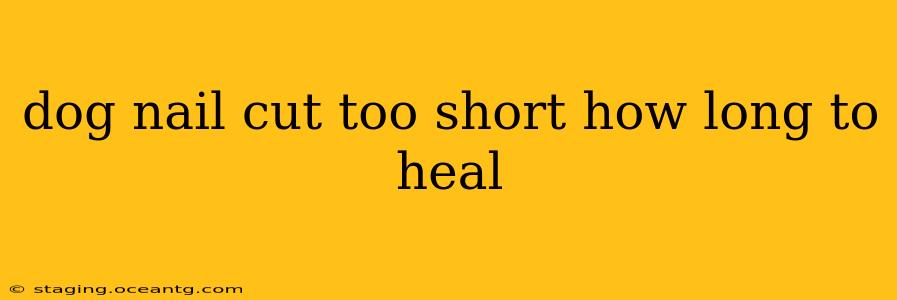Accidentally cutting your dog's nail too short is a common mishap for even experienced pet owners. It's distressing for both you and your furry friend, as it can be quite painful and lead to bleeding. But how long does it take to heal, and what steps should you take to ensure a speedy recovery? This comprehensive guide will address your concerns and provide practical advice.
How Long Does it Take for a Dog's Nail to Heal After Being Cut Too Short?
The healing time for a dog's nail that's been cut too short depends on several factors:
- Severity of the cut: A minor nick will heal much faster than a deep cut that reaches the quick (the pink part of the nail containing nerves and blood vessels).
- Your dog's breed and size: Larger dogs may have thicker nails that take longer to heal.
- Your dog's overall health: A dog with a compromised immune system might heal more slowly.
- Proper aftercare: Following the right steps to stop bleeding and keep the area clean significantly impacts healing time.
Generally, a minor cut will heal within a few days to a week. However, a more severe cut requiring veterinary attention could take several weeks to fully heal, and might even necessitate antibiotics.
What to Do if You Cut Your Dog's Nail Too Short?
Immediate Actions:
-
Apply Pressure: The first and most crucial step is to apply firm, direct pressure to the bleeding nail. Use a clean cloth or cotton ball to stem the flow of blood. Holding for several minutes is usually sufficient, but be prepared to continue for longer if necessary.
-
Styptic Powder (Optional): Styptic powder is a common remedy for canine nail bleeds. It helps to clot the blood quickly. Follow the product instructions carefully. If bleeding doesn't stop, seek veterinary help immediately.
-
Keep it Clean: Once the bleeding stops, keep the nail clean and dry to prevent infection. Gentle cleaning with a mild antiseptic solution can be beneficial.
Long-Term Care:
-
Monitor for Infection: Watch for signs of infection, such as swelling, increased pain, redness, pus, or a foul odor. If you notice any of these, contact your veterinarian immediately.
-
Avoid Licking: Dogs will naturally try to lick or chew at their injured nails. Consider using a protective cone or bandage (with your vet's guidance) to prevent this, as licking can hinder healing and introduce infection.
-
Pain Management (If Needed): For severe cuts, your veterinarian may recommend pain medication.
How to Prevent Cutting Your Dog's Nails Too Short?
Prevention is key! Here are some tips to avoid future nail-cutting mishaps:
-
Good Lighting: Ensure you have ample, bright light to clearly see the quick. Natural daylight is ideal.
-
Sharp Clippers: Use sharp nail clippers designed for dogs. Dull clippers crush the nail, making it more likely to hit the quick.
-
Cut in Small Increments: It's better to trim a little at a time than risk cutting too much in one go.
-
Familiarize Yourself with the Quick: Take your time to observe your dog's nails and get comfortable identifying the quick. If unsure, consult with your veterinarian or a professional groomer.
-
Consider Professional Grooming: If you're uncomfortable trimming your dog's nails, consider taking them to a professional groomer for regular nail trims.
Can I use a human nail clipper on my dog?
No, it's generally recommended not to use human nail clippers on dogs. Dog nails are much thicker and tougher than human nails, and human clippers may not be able to cut through them effectively. Furthermore, the shape and design of dog nail clippers are specifically created to cut the nail at the right angle, minimizing the risk of injuring the quick. Using an unsuitable clipper increases the chances of an accident.
What should I do if my dog's nail is bleeding profusely?
If your dog's nail is bleeding profusely after you've cut it too short, you should seek immediate veterinary attention. Applying pressure and styptic powder as described earlier is a good first step, but a vet will be able to provide more effective and potentially necessary treatment if the bleeding doesn't stop, or if you're concerned about the severity of the injury. Don't delay – prompt action is vital to stop bleeding and prevent infection.
My dog is limping after I cut his nails, what could be the cause?
Limping after a nail trim is a sign that the quick may have been cut, causing pain and discomfort. The severity of the limp depends on how deeply the quick was cut. If the limp persists, or your dog seems excessively painful, seek immediate veterinary care. This is a symptom that shouldn’t be ignored. Your vet can assess the situation and provide the appropriate treatment.
Remember, preventing accidental cuts is always the best approach. If you're ever unsure, consult with a professional. By following these tips and seeking veterinary advice when necessary, you can ensure your dog’s nails are trimmed safely and they remain healthy and happy.
